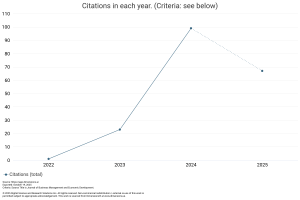Utilization of Waste Based Construction Materials Advancing Towards a Green Economy
DOI:
https://doi.org/10.59653/jbmed.v3i02.1534Keywords:
Sustainable construction, Waste based materials, Circular economy, Fly ash concrete, Plastic and glass recyclingAbstract
The construction industry's growing environmental impact necessitates the adoption of sustainable materials and practices. This study explores the integration of waste-based materials plastic waste, glass waste, and fly ash into construction applications as an innovative approach to reducing environmental degradation and promoting a circular economy. Chemical recycling, photocatalytic conversion, and thermochemical processes enhance the potential of plastic waste in construction, particularly in road infrastructure. Similarly, waste glass powder (WGP) improves the mechanical properties of geopolymer concrete, while crushed glass serves as a sustainable substitute for natural sand in concrete production. Additionally, fly ash contributes to cement replacement, reducing carbon emissions and improving the long-term durability of concrete structures. The findings indicate that incorporating waste-based materials into construction reduces material costs by 15–30% and enhances durability by up to 40%, highlighting both economic and environmental benefits. Despite these advantages, challenges such as material variability, processing costs, and market acceptance remain key obstacles. Overcoming these barriers requires coordinated efforts among policymakers, industry stakeholders, and researchers to establish standards, incentives, and awareness programs that facilitate the transition towards sustainable construction practices.
Downloads
References
Abdy, C., Zhang, Y., Wang, J., Yang, Y., Artamendi, I., & Allen, B. (2022). Pyrolysis of polyolefin plastic waste and potential applications in asphalt road construction: A technical review. Resources, Conservation and Recycling, 180, 106213. https://doi.org/10.1016/j.resconrec.2022.106213
Ahmed, H. U., Mohammed, A. A., & Mohammed, A. (2022). Soft computing models to predict the compressive strength of GGBS/FA- geopolymer concrete. PLOS ONE, 17(5), e0265846. https://doi.org/10.1371/journal.pone.0265846
Amin, M., Agwa, I. S., Mashaan, N. S., Mahmood, S., & Abd-Elrahman, M. H. (2023). Investigation of the Physical Mechanical Properties and Durability of Sustainable Ultra-High Performance Concrete with Recycled Waste Glass. Sustainability, 15(4), 3085. https://doi.org/10.3390/su15043085
Aslam, F., Zaid, O. F., Althoey, F., Alyami, S. H., Qaidi, S. M. A., de Prado Gil, J., & Martínez-García, R. (2022). Evaluating the influence of fly ash and waste glass on the characteristics of coconut fibers reinforced concrete. Structural Concrete, 24(2), 2440–2459. https://doi.org/10.1002/suco.202200183
Bohre, A., Jadhao, P. R., Tripathi, K., Pant, K. K., Likozar, B., & Saha, B. (2023). Chemical recycling processes of waste polyethylene terephthalate using solid catalysts. Chemsuschem, e202300142. https://doi.org/10.1002/cssc.202300142
Çelik, A. İ., Tunç, U., Bahrami, A., Karalar, M., Mydin, A. O., Alomayri, T., & Özkılıç, Y. O. (2023). Use of Waste Glass Powder toward more Sustainable Geopolymer Concrete. Journal of Materials Research and Technology, 24, 8533–8546. https://doi.org/10.1016/j.jmrt.2023.05.094
Chen, X.-Y., Zhang, D., Cheng, S., Xu, X., Zhao, C., Wang, X., Wu, Q., & Bai, X. (2022). Sustainable reuse of ceramic waste powder as a supplementary cementitious material in recycled aggregate concrete: Mechanical properties, durability and microstructure assessment. Journal of Building Engineering, 52, 104418. https://doi.org/10.1016/j.jobe.2022.104418
Chu, S., Zhang, B., Zhao, X. Y., Soo, H. Sen, Wang, F., Xiao, R., & Zhang, H. (2022). Photocatalytic Conversion of Plastic Waste: From Photodegradation to Photosynthesis. Advanced Energy Materials, 12(22), 2200435. https://doi.org/10.1002/aenm.202200435
Damayanti, D., Saputri, D. R., Marpaung, D. S. S., Yusupandi, F., Sanjaya, A., Simbolon, Y. M., Asmarani, W., Ulfa, M., & Wu, H. (2022). Current Prospects for Plastic Waste Treatment. Polymers, 14(15), 3133. https://doi.org/10.3390/polym14153133
Danish, A., Ozbakkaloglu, T., Mosaberpanah, M. A., Salim, M. U., Bayram, M., Yeon, J. H., & Jafar, K. (2022). Sustainability benefits and commercialization challenges and strategies of geopolymer concrete: A review. Journal of Building Engineering, 58, 105005. https://doi.org/10.1016/j.jobe.2022.105005
Dobiszewska, M., Bagcal, O., Beycioğlu, A., Goulias, D. G., Köksal, F., Płomiński, B., & Ürünveren, H. (2023). Utilization of rock dust as cement replacement in cement composites: An alternative approach to sustainable mortar and concrete productions. Journal of Building Engineering, 69, 106180. https://doi.org/10.1016/j.jobe.2023.106180
Gopalakrishna, B. V, & Dinakar, P. (2023). Mix design development of fly ash-GGBS based recycled aggregate geopolymer concrete. Journal of Building Engineering, 63, 105551. https://doi.org/10.1016/j.jobe.2022.105551
Huang, J., Lisak, G., Veksha, A., Chan, W. P., Giannis, A., & Lisak, G. (2022). Chemical recycling of plastic waste for sustainable material management: A prospective review on catalysts and processes. Renewable & Sustainable Energy Reviews, 154, 111866. https://doi.org/10.1016/J.RSER.2021.111866
Liu, M., Wu, H., Yao, P., Wang, C., & Ma, Z. (2022). Microstructure and macro properties of sustainable alkali-activated fly ash mortar with various construction waste fines as binder replacement up to 100%. Cement & Concrete Composites, 134, 104733. https://doi.org/10.1016/j.cemconcomp.2022.104733
Maitlo, G., Ali, I., Maitlo, H. A., Ali, S., Unar, I. N., Ahmad, M. B., Bhutto, D. K., Karmani, R. K., Naich, S. U. R., Sajjad, R. U., Ali, S., & Afridi, M. N. (2022). Plastic Waste Recycling, Applications, and Future Prospects for a Sustainable Environment. Sustainability, 14(18), 11637. https://doi.org/10.3390/su141811637
Mishra, R., Kumar, A., Singh, E., & Kumar, S. (2023). Recent Research Advancements in Catalytic Pyrolysis of Plastic Waste. ACS Sustainable Chemistry & Engineering, 11(6), 2033–2049. https://doi.org/10.1021/acssuschemeng.2c05759
Nafees, A., Khan, S., Javed, M. F., Alrowais, R., Mohamed, A. M., Mohamed, A., & Vatin, N. I. (2022). Forecasting the Mechanical Properties of Plastic Concrete Employing Experimental Data Using Machine Learning Algorithms: DT, MLPNN, SVM, and RF. Polymers, 14(8), 1583. https://doi.org/10.3390/polym14081583
Nayak, D. K., Abhilash, P. P., Singh, R., Kumar, R., & Kumar, V. (2022). Fly ash for sustainable construction: A review of fly ash concrete and its beneficial use case studies. Cleaner Materials, 6, 100143. https://doi.org/10.1016/j.clema.2022.100143
Neo, E. R. K., Yeo, Z., Low, J. S. C., Goodship, V., & Debattista, K. (2022). A review on chemometric techniques with infrared, Raman and laser-induced breakdown spectroscopy for sorting plastic waste in the recycling industry. Resources, Conservation and Recycling, 180, 106217. https://doi.org/10.1016/j.resconrec.2022.106217
Nikiema, J., & Asiedu, Z. (2022). A review of the cost and effectiveness of solutions to address plastic pollution. Environmental Science and Pollution Research, 29(17), 24547–24573. https://doi.org/10.1007/s11356-021-18038-5
Nilimaa, J. (2023). Smart materials and technologies for sustainable concrete construction. Developments in the Built Environment, 15, 100177. https://doi.org/10.1016/j.dibe.2023.100177
Ogunmakinde, O. E., Egbelakin, T., & Sher, W. (2022). Contributions of the circular economy to the UN sustainable development goals through sustainable construction. Resources, Conservation and Recycling, 178, 106023. https://doi.org/10.1016/j.resconrec.2021.106023
Shanker, R., Khan, D., Hossain, R., Islam, M. T., Locock, K., Ghose, A., Sahajwalla, V., Schandl, H., & Dhodapkar, R. (2023). Plastic waste recycling: existing Indian scenario and future opportunities. International Journal of Environmental Science and Technology, 20(5), 5895–5912. https://doi.org/10.1007/s13762-022-04079-x
Tanveer, M., Khan, S. A. R., Umar, M., Yu, Z., Sajid, M. J., & Haq, I. U. (2022). Waste management and green technology: future trends in circular economy leading towards environmental sustainability. Environmental Science and Pollution Research, 29(53), 80161–80178. https://doi.org/10.1007/s11356-022-23238-8
Wong, L. S. (2022). Durability Performance of Geopolymer Concrete: A Review. Polymers, 14(5), 868. https://doi.org/10.3390/polym14050868
Xiao, R., Huang, B., Zhou, H., Ma, Y., & Jiang, X. (2022). A state-of-the-art review of crushed urban waste glass used in OPC and AAMs (geopolymer): Progress and challenges. Cleaner Materials, 4, 100083. https://doi.org/10.1016/j.clema.2022.100083
Yang, R.-X., Jan, K., Chen, C., Chen, W., & Wu, K. C.-W. (2022). Thermochemical Conversion of Plastic Waste into Fuels, Chemicals, and Value‐Added Materials: A Critical Review and Outlooks. ChemSusChem, 15(11). https://doi.org/10.1002/cssc.202200171
Youssf, O., Elchalakani, M., Hassanli, R., Roychand, R., Zhuge, Y., Gravina, R. J., & Mills, J. E. (2022). Mechanical performance and durability of geopolymer lightweight rubber concrete. Journal of Building Engineering, 45, 103608. https://doi.org/10.1016/j.jobe.2021.103608
Zhang, P., Sun, X., Wang, F., & Wang, J. (2023). Mechanical Properties and Durability of Geopolymer Recycled Aggregate Concrete: A Review. Polymers, 15(3), 615. https://doi.org/10.3390/polym15030615
Zhong, H., & Zhang, M. (2023). Engineered geopolymer composites: A state-of-the-art review. Cement and Concrete Composites, 135, 104850. https://doi.org/10.1016/j.cemconcomp.2022.104850
Downloads
Published
How to Cite
Issue
Section
License
Copyright (c) 2025 Setiyono, Nurul Bahiyah Binti Abd Wahid

This work is licensed under a Creative Commons Attribution-ShareAlike 4.0 International License.
Authors who publish with this journal agree to the following terms:
- Authors retain copyright and grant the journal right of first publication with the work simultaneously licensed under a Creative Commons Attribution-ShareAlike that allows others to share the work with an acknowledgement of the work's authorship and initial publication in this journal.
- Authors are able to enter into separate, additional contractual arrangements for the non-exclusive distribution of the journal's published version of the work (e.g., post it to an institutional repository or publish it in a book), with an acknowledgement of its initial publication in this journal.
- Authors are permitted and encouraged to post their work online (e.g., in institutional repositories or on their website) prior to and during the submission process, as it can lead to productive exchanges, as well as earlier and greater citation of published work (See The Effect of Open Access).





























